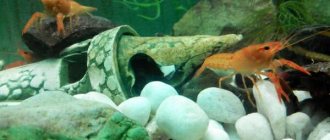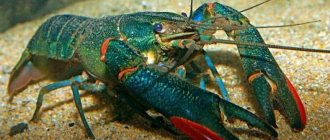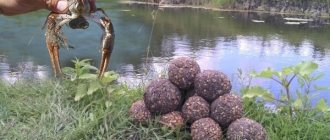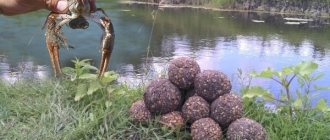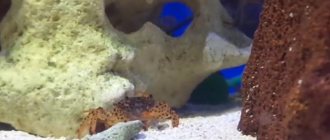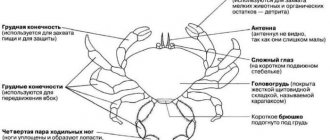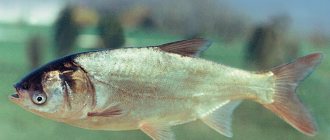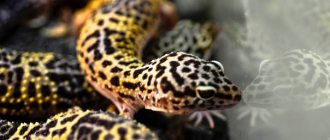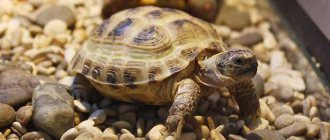December 7, 2013 Victor Home page » Pisces Views:
Welcome to my blog! In this article I will describe how crayfish work, where they live, the lifestyle and nutrition of crayfish.
Crayfish belong to the order of decapod crustaceans. I'll start with a description of crayfish, where they live, how they spend their lives, what they feed on, where they hide from their enemies. Be sure to read this interesting article about how to catch crayfish.
Personally, I like to catch crayfish by diving for them. I find this more interesting than getting them out of traps. But sometimes you have to set traps. Now let's look at crayfish in more detail.
How do crayfish work?
The forelimbs are highly developed, they are designed to hold food and protect from enemies. Behind the claws there are four pairs. they are designed to move the crayfish along the bottom of the reservoir. Five more underdeveloped pairs are under the tail. The anterior ones have tubular genital organs; females do not have these organs. Young males can be distinguished from females only by these genitals. Large ones are easier to distinguish - males have larger claws than females, but the tail of females is wider than that of males. Females hide eggs under their wide tails.
Unscheduled molts: what is behind it and possible consequences
In addition to planned ones, there are cases of unplanned molting, which are usually caused by a sharp change in water parameters. Note that this can be very dangerous if the individual has not yet recovered from the previous molt.
In females, the molting process is also observed before mating and after the appearance of fry. Please note that molting during gestation is an atypical phenomenon, most likely caused by deviations in water parameters. The eggs that are shed along with the shell die. Usually the owner of the shell does not survive either.
Therefore, try not to cause stress to the pregnant female, for example, by transferring her to another container to avoid the death of the fry.
Shrimps get rid of their shell very quickly, literally in a couple of minutes: when the time comes, the arthropods begin to “itch,” thereby causing the formation of a crack in the shell. Through the resulting hole, water begins to flow inside. The shrimp freezes motionless and within a minute, with a sharp movement, frees itself from the old shell. In crayfish, this process occurs more slowly due to the difficulties encountered in removing the claws. They often lose one of their limbs during the molting process.
Crayfish habitat
The only higher crustacean that is found in Russia under natural conditions is crayfish. Crayfish are very picky about their environment. They live only in clean and fresh water. Crayfish do not reproduce in salt water. Crayfish live in both dark and light water; The water should be saturated with oxygen and should not have a high acid content. Crayfish can live in different bodies of water, but they mainly prefer rivers.
Crayfish prefer a hard bottom, mostly without silt. They make shelters for themselves in rocks and various holes. Because they can’t dig them themselves. Crayfish burrows are long and narrow. Cancers feel safe in them. The presence of fresh soil at the entrance to the burrow indicates the presence of an owner there. Large males choose their burrows better, the rest go to females and smaller crayfish. Young crayfish live in shelters without holes near the coast.
The procedure for updating the protective shell
However, the protective shell does not grow with its owner, and all crustaceans regularly exchange it for a new one, while the epidermis is separated from the calcareous skeleton. This happens thanks to a special hormone ecdysone and is called molting. For normal ecdysone production, invertebrates need to be provided with a good balanced diet.
Molting occurs throughout the life of shrimp. At the same time, young individuals molt much more often because they grow quickly. At the age of up to 3 months, they change their shell every 4-5 days, and in adults this metamorphosis occurs once every one and a half to two months.
To build a new external skeleton, the body resorts to previously accumulated “fat reserves.” Therefore, if an individual does not receive the necessary substances, various pathologies may occur and even the death of the shrimp.
Crayfish growth
The growth of crayfish primarily depends on the environment. Water quality, food abundance, water temperature. Because of this, crayfish develop differently in different bodies of water. The first two years, males and females develop equally, but after that, males become larger than females. The length of large males is 16 cm, females 12 cm. It is impossible to accurately determine the age of caught crayfish. It is determined only in comparison with other cancers, knowing their age. There are also long-livers who have reached 20 years of age.
Molting crayfish
Molting is a crucial period in the life of crayfish; during molting, crayfish renew their entire body and their growth also occurs. During the period of preparation for molting, crayfish hide in holes. The molting itself occurs quickly, only a few minutes, and the crayfish crawl out to do this. After molting, the crayfish hide back in the hole, since the shell is soft and the crayfish is defenseless, for several weeks. During this time, it does not feed and cannot be caught.
Crayfish molt only when it is warm. Adult crayfish molt twice per season, females once. Molting of crayfish begins only when the eggs separate from the tail and the larvae emerge. If the weather is cold in summer, molting may begin later than usual.
Nutrition
The process of food absorption by cancer resembles a whole meal. The crayfish eats its prey piece by piece, slowly, as if prolonging the pleasure. Thus, a crayfish can spend 2-4 minutes to eat a small insect. Ichthyologists boldly call crayfish omnivores. The main component of the diet of underwater inhabitants consists of plant food, small insects, worms, mollusks, and dead fish. In practice, cases of cannibalism are observed, that is, crayfish can attack their own kind. Excessive aggressiveness is observed during molting, as well as after it.
Have you prepared for summer perch fishing?
Basics of fishing
How to make a simple donka for a beginner
Reproduction of crayfish
Males become ready for reproduction after 3–4 years, with a length of 7 centimeters, females at the age of 4–6 years with a length of 8 centimeters. You can understand about sexual maturity by looking under the tail of males, where the twisted reproductive tubes are filled with white liquid; in females, the presence of eggs and mucous glands indicates their readiness to mate. Which happens in the fall.
Crayfish mate in the same place where they live. Males turn females onto their backs and attach spermatophores to the female's genital opening. After a couple of weeks, the female, turning over on her back, lays eggs on her tail, from 100 to 400 eggs. Which are held on by glands secreted by the female.
From autumn to early summer, the eggs are located under the female's tail. During this time, there are fewer eggs. In June–July, the larvae emerge from the eggs. The larvae are about a centimeter in size and look like small crustaceans. They stay under the female’s tail until the yolk, which is under the female’s tail, runs out. Then they begin an independent life.
Crayfish nutrition
Crayfish are omnivorous animals. It feeds on small organisms and plants, and does not disdain its fellows that are weak or defenseless due to molting. But most of all, crayfish prefer plant foods, larvae. The cancer eats its victim alive, holding it with its claws and biting piece by piece.
Crayfish practically does not feed on fish, since it cannot catch it. He only gets that fish. who swims close to cancer or is sick and immobile. Thus, the cancer cleanses the reservoirs of bad and dead fish. Crayfish also love to eat fish eggs. But the main food of crayfish is bottom organisms and vegetation.
Breeding and keeping crayfish
CANCER BREEDING AND KEEPING
Crayfish are very valuable invertebrate animals that are constantly in great demand in all corners of the globe. But, unfortunately, their natural populations decrease every year, which is facilitated by poaching, various epizootics that occur periodically and other reasons. It has been established that natural reserves of crayfish reach a maximum every 7 years, after which they begin to decline to a minimum.
In recent years, much attention has been paid to breeding crayfish in artificial reservoirs. Türkiye is the leader here, where crayfish were once brought from the reservoirs of Ukraine. It annually supplies up to 7 thousand tons of commercial crayfish to the foreign market; somewhat less - Spain (3.5 thousand tons) and China (1 thousand tons).
In homestead and country ponds, you can successfully cultivate crayfish of such fast-growing species as broad-toed (Astacus astacus) and long-toed crayfish (Pontostacus lepto-dactylus).
Crayfish can live in any fresh water bodies - rivers, lakes, estuaries, reservoirs, ponds, etc. They love clean natural bodies of water, not polluted by chemical, household or industrial waste (it’s not for nothing that they are considered indicators of clean water), the depth of which is usually 2 -5 m, but in some cases it can reach up to 8-15 m. The ideal habitat for crayfish is the shoreline of a reservoir with inlets, where aquatic vegetation (elodea, chara, hornwort, etc.) develops well, covering (but not completely) the bottom of the reservoir. When eating algae, calcium metabolism in the animal's body accelerates, and this contributes to the hardening of the shell after molting. Crayfish prefer a fairly dense bottom (sandy, clayey) with the presence of calcareous rocks, stones, as well as reservoirs with normal or high mineralization of water. The soil of the shore and the bottom of the reservoir should be such that it is convenient for crayfish to build holes, although they can also live under stones, roots, and stumps.
Most often, crayfish build burrows on steep, shady banks where there is little sun. The usual dimensions of burrows are: length - 7-36 cm, width - 4-18 cm, height - 2-16 cm. In winter they are located at greater depths, and in summer - at shallower depths. Crayfish dig their burrows using their legs and tail, relying on their front claws. By the way, they need a tail not only for digging holes, but also for swimming. Crayfish, as you know, swim backwards and at the same time hit the water with their tail. They move along the bottom slowly and often also backwards. It happens that crayfish leave ponds with polluted water, moving on land. As a rule, they do not live in acidic water. The optimal amount of oxygen dissolved in water for crayfish is 6-7 mg/l, but a short-term decrease in its level to 2-3 mg/l is acceptable.
Typically, crayfish are nocturnal, but if they smell prey, they will strive for it, regardless of the time of day. Another interesting fact is that females always sit alone in burrows, while during wintering males often gather in groups and bury themselves in the mud.
Crayfish are dioecious animals. Males of long-clawed crayfish, for example, reach maturity in the third year of life with a body length of 8 cm, and females only in the fourth year with a body length of 7 cm. As a rule, male crayfish are 2-3 times larger than females. Mating occurs either in autumn (October-November) or at the end of winter - early spring (February-March) at a water temperature of 10°C. Duration of mating is 2-3 weeks, fertilization is external. Males glue their spermatophores to the underside of the female's cephalothorax in the form of a white spot. With late mating and low temperatures, fertilization occurs within a few days.
Females lay eggs at night, in silence, for 2-3 hours. By bending the abdomen to the cephalothorax, they form a chamber into which they release a special substance that dissolves the spermatophores with spermatozoa attached there. The eggs, squeezed out of the oviduct, pass through the seminal solution, are fertilized and attach to the abdominal legs or shell. The fertility of females depends on their size, physiological state, time of year and other factors. They can have 110-480 eggs on their legs. Thanks to the movements of the walking and abdominal legs, the eggs are constantly washed with fresh water. During the period of gestation, females are very careful, hiding in burrows and emerging from them only in search of food. The embryos in the eggs develop within 7-8 weeks. At this time, the female carefully looks after the eggs, washes them with water and cleans them of mucus.
Small crustaceans (larvae) hatch from eggs most often in the third ten days of May and the first ten days of July at a temperature of 21-24 °C. For the first 2-3 days they hang on the so-called hyaline threads, then the threads break off, and the crustaceans are attached to the egg shell using small backward-curved hooks on the claws. They remain in this state for 5-8 days, feeding only on the reserves of the yolk, which is located under the dorsal shell of the cephalothorax of the babies. Before the tenth day, the first molt occurs, after which the larvae become similar to adult crayfish. Their weight is 21-30 mg, body length is 1.1-1.2 cm. The crustaceans feed on their own, but under unfavorable conditions they hide under the mother’s abdomen.
On the thirteenth to twentieth day, the second molt occurs, after which the larvae become completely independent. During the molting period, crustaceans are in shelter. During this time, they grow up, straighten their legs and begin to move their claws, whiskers, and eyes. A gap appears between the cephalothoracic shield and the abdomen, from which the crustaceans protrude their soft body. Sometimes the claws and legs are torn off, but then they are restored. Most often, molting occurs between May and August. Crayfish molt repeatedly: in the first year of life - 8 times, in the second - 4-5 and in the third - 3-4 times. The first 1-1.5 months of life for small crustaceans is a very dangerous period: they are especially susceptible to disease, they can be eaten by fish, muskrats, and waterfowl.
Another interesting detail from the life of crayfish. In search of food, they migrate, feeding mainly on invertebrates (worms, mollusks, insects and their larvae, small crustaceans, etc.), as well as calcium-rich aquatic vegetation and small fish. It is very interesting to watch the process of crayfish eating food. If the prey is close to the hole, then they take it to their shelter; if it is far away, the crayfish eats the prey on the spot, hiding in any shelter.
The optimal ambient temperature for adequate nutrition of adult crayfish is 17-21°C, larvae - 18-23°C. Despite the careful care of females for their offspring, crayfish can eat each other. This phenomenon is due to the group lifestyle of animals, frequent molting, and uneven growth. Large individuals eat smaller ones.
Cancers, like all animals, get sick. They are often affected by plague and rust spot disease. Various molluscs (especially dracena and filamentous algae) can settle on the shell of animals, but when molting, crayfish discard them.
Crayfish farming is practiced in many countries around the world. In addition to Turkey, Spain and China, these are Russia, the USA, Germany, etc. Each country has developed its own technology for the production of crayfish, but the main requirements are the following: the presence of reservoirs with a low-silt clay bottom and water enriched with oxygen, maintaining a constant summer temperature and hydrochemical regime. For breeding crayfish, you can use specialized farm plots, as well as small private plots and household plots with ponds.
There are two types of crayfish breeding farms - pond and factory. The first one is considered the most economically profitable, since crayfish breeding is a rather labor-intensive process. It is advisable for beginning crayfish farmers to start by raising fingerlings, the sale of which, with a constant market, can provide a significant profit.
When breeding crayfish, it is important to harvest females with live eggs on pleopods (legs) and transport them to crayfish farms. To grow 1 ton of crayfish, it is necessary to prepare 500-600 females; They are caught in natural bodies of water. On the farm (small ponds, pools or special devices), pre-incubation of embryos located on pleopods is carried out. It is very important to create good water exchange and aeration of the water.
When breeding crayfish, it is necessary to constantly monitor the quality of water, control the amount of oxygen dissolved in it (at least 5-7 mg/l) and hydrogen (7-9 mg/l). Water exchange should be approximately 50 l/min per 1000 sq. m of water area. You should also carefully study the natural food resources of the reservoir: algae, zooplankton, worms, “trash” fish, etc. The presence of natural food resources allows you to reduce the cost of raising fingerlings and commercial crayfish.
Crayfish breeders are placed in ponds (area - about 0.1 hectares, depth - 1-1.5 m, planting density - 1-5 pieces per 1 sq. m). When the water temperature is above 7 °C, crayfish are fed fresh or cooked food (meat, slaughterhouse waste, vegetables, shellfish, etc.). The average daily intake should be 2% of the body weight of the cancer. The food is placed on wooden trays (40x40 cm). With the pond method of breeding crayfish, the first stage larvae hatch in May - June. After the second molt, juveniles (animals that have not yet reached the size of adult crayfish) are caught and transplanted into a uterine pond, and small crustaceans are raised to fingerlings weighing 7-10 g. They can be raised in the same pond or transplanted into another where the conditions meet the requirements wintering. Yearling crayfish are caught and transplanted into feeding ponds, where the stocking density is lower than in the previous reservoir. At the end of the second or third year of life, crayfish reach a marketable weight of 40-50 g with a length of 9-10 cm.
You can also keep and breed crayfish at home (aquariums, baths), but in this case only a small number of larvae (crustaceans) are obtained. Feeding and preserving them causes a lot of trouble. Thus, it is very difficult to grow crayfish to marketable mass at home.
To obtain 3-4 kg/ha of marketable crayfish production, it is necessary to have at least 3-4 properly prepared ponds.
Crayfish, as is known, do not live in polluted water, so their meat is cleaner than that of other aquatic animals. And they themselves perform the function of orderlies in the pond, cleaning the reservoirs from organic residues.
It is recommended to breed broad-toed and long-toed crayfish in a home pond. The broad-clawed crayfish has wide claws, a smooth shell, and a body length of about 15 cm. The long-clawed crayfish has narrow and long claws and a rough shell; The body length reaches 20 cm, the weight of the male is more than 300 g.
In winter, crayfish go deeper and burrow into the mud. They are comfortable here and have enough food. In winter, as is known, there is not enough oxygen in the water; some fish suffocate, fall to the bottom and become prey for crayfish, which, even in conditions of low temperature, do not stop actively feeding.
Crayfish are caught with special fishing rods, crayfish and nets, from mid-summer to late autumn. A good catch occurs in dark waters in the evening, and in clear waters from dusk until midnight. The best fishing occurs on dark, warm nights and in rainy weather.
In order for the caught crayfish to be better preserved and not attack each other, they must be fed with nettles, alder leaves, potatoes and other vegetation. It is not recommended to give fresh fish, since the crayfish get into fights during which they lose their claws and legs, which means , marketable condition.
Crayfish diseases
Crayfish get sick just like fish. These are infections and parasites. The general weakness of the crayfish’s body is affected by: poor water condition (pollution), lack of shelter, lack of food, and the presence of parasites. Diseases can also be affected by injuries received after battles. The main disease of crayfish is crayfish plague.
Crayfish plague
The cause of crayfish plague is a fungus. Bacteria develop in the skin. From a cancer patient, plague spores in the form of a web pass onto the shell of a healthy person and damage it. The disease can only be accurately determined in a laboratory. A person suffering from the cancer plague lacks the instinct of self-preservation and protection. They walk as if drunk on straight legs with their tail between their legs. To avoid the plague, it is necessary to isolate sick crayfish and prohibit fishing in these reservoirs. It is also found in cancer and other diseases.
Be sure to read how to catch crayfish
To Home Page.
Formation of a new protective shell
Outwardly, this process occurs painlessly. But growing a new exuvium is a longer and more difficult process. The body of a molted shrimp is very defenseless, the integument is unusually soft and tender. It is during this period that the shrimp grows, because being in a hard shell it cannot grow. Water penetrates the shrimp's body, due to which muscle tissue begins to grow rapidly. A new shell is formed within two to three days. For crayfish - up to 10 or more days. The process of restoring lost limbs can take several molting cycles in adults, but in young animals regeneration occurs in one molting.
Invertebrate response to molting
Having lost their protection, invertebrates become timid, hide in the most shaded corners of the reservoir and try not to leave their shelter. Therefore, it is extremely important to provide in advance a sufficient number of shelters in the aquarium, which can be gorges between stones, artificial grottoes or thickets of aquarium plants. Most species behave very passively during molting: a shrimp that has shed its protective shell can lie for several hours or even days, showing practically no signs of life.
Shrimp lose their appetite before and during the shedding of their protective shell, but after the shell is shed, they often eat it to replenish the nutrients needed to strengthen the new shell.
What is shell shedding?
Shell shedding occurs when your crab needs to “trade in” its housing and exoskeleton to accommodate its larger body size. He will leave his current shell to find a more suitable one. However, not all crayfish that shed their shells molt. Stress, an unfavorable environment, a poorly fitting shell (too big, too small, too heavy) and unwanted company can all cause a hermit crab to leave its shell. When this happens, your stray crab suddenly becomes surrounded, becoming too dry and lethargic.
Breeding under artificial conditions
To breed crayfish, you will need two or three containers made of plastic or plexiglass, but not metal. The larger these containers are, the better. These containers can be made independently, based on the size of the room.
In the first two years, it is not necessary to install all the “reservoirs” permanently, since due to a lack of experience, various problems may arise: a clogged drain, a crack, the need to install a larger and stronger container.
A significant advantage of keeping crayfish artificially is that young crayfish will not be devoured by any predators. There will be no frogs, no fish, or anyone who could eat crayfish in the containers. However, large crayfish can eat small ones, and in a cramped container this is inevitable.
Precisely, in order to avoid these troubles, several aquariums are required at once. When new offspring appear, adult crayfish are transplanted into another container. It is impossible to do the opposite, since in the body of water where the offspring appeared, conditions already exist that are favorable for their development and growth.
After the appearance of the offspring, the water is not changed for several days, since the crustaceans are so small that they can get into the drain even through a fine grate.
You don’t have to invest a lot of money to keep crayfish, but you will have to constantly monitor your pets and do a lot of things yourself. First of all, you need to monitor the temperature in the room. The more comfortable the temperature, the larger and faster the crayfish grow.
The bottom of the “reservoirs” must be arranged accordingly, that is, sprinkle the bottom with river sand and add some stones. If this is not done, then the crayfish will have nowhere to make holes for themselves.
It is important not to forget to constantly feed the crayfish. Crayfish are unpretentious and can eat almost anything; their menu includes frogs, fish, sometimes plants, insects, larvae, worms, some types of porridge, etc. However, you should not be too zealous - overfeeding crayfish is much worse than underfeeding them.
Keeping ordinary crayfish is useless; they are not suitable for breeding. To succeed, you should purchase the so-called Cuban or blue crayfish. These crayfish, unlike ordinary ones, quickly reach marketable sizes.
To maintain “reservoirs” it is necessary to have special purification filters, which will eliminate the need to change the water very often and negatively affect the condition and growth of crayfish.
To conveniently catch crayfish, you need to acquire special means at hand that will not injure them.
Aquarium content
A small aquarium is suitable for one crayfish. If you systematically change the water, then thirty to forty liters is enough. Cancers have one unpleasant way. They often try to hide their food, which can often be found in their hiding places. And if there are a lot of these residues, then an imbalance may occur in the aquarium; regular water changes and systematic cleaning can help. In this case, pay special attention to searching for these residues during cleaning using a siphon. Discover and explore all his shelters, grottoes, pots and other secluded places.
Great hideout
If you plan to keep several crayfish, then you will need a larger aquarium - from 80 liters. Such an aquarium will not only decorate your home, but can also be the start of a small crayfish breeding business. It is also worth knowing that crayfish have an unpleasant habit of eating their own kind, especially during the molting period. Therefore, the aquarium should not only be spacious, but it should also have various shelters in which the molting crayfish will hide.
An internal filter is more suitable for filtering water. Because the hoses that go to the outside can become an excellent path along which aquarium crayfish will get out of the aquarium. Someday when you come home from work, or wake up early in the morning, you will see him crawling on the floor. Don't forget, crayfish are very skilled escape artists!
Feeding and basic diet
The Australian crayfish is called a vegetarian, which is not true.
He eats both plant and animal foods.
Its menu may include snails, frogs, small fish and even relatives.
The diet should be varied, and it is important to take into account your favorite dish - beech or oak leaves.
In nature, crayfish consume them every day, getting full and at the same time preventing diseases. The absence of such foliage in the diet leads to disease.
Suitable Products:
- store-bought fish food;
- worms, bloodworms, frozen larvae;
- pureed, boiled vegetables;
- stale bread soaked in water;
- boiled egg white and shell.
Products to avoid:
- raw vegetables;
- apples;
- raw meat products;
- fresh bread;
- banana peel;
- minced fish or meat;
- boiled yolk.
These products not only harm your pet, but also seriously spoil the water.
Preventing mass mortality of crayfish on the farm
If the following indicators are detected:
- convulsions, unusual movements of crayfish;
- the cover of the cancer is changed (ulcers, blood clots on the gills, hardened substances, white coloration of the underside of the tail, etc.);
- parasites noticed;
- the number of sick crayfish corresponds to dead ones;
- changes in water in diversion ponds (surface films, turbidity, color, smell, etc.),
then it is urgent to take measures to prevent the death of crayfish. From a body of water where any changes, illness or death of crayfish are noticed, it is necessary to take water for examination (always in clean bottles). Also, for research, you should take 5-7 dying or dead crayfish. Dead crayfish are wrapped in wet parchment paper. You cannot use plastic bags! Dead crayfish can be preserved in formalin solution (4%). Live crayfish are transplanted into a cardboard box with grass or moss. These crayfish are also sent for research.
| Read the article about catching crayfish |
Procurement of producers and obtaining embryos
Procurement of crayfish producers for further breeding for sale is carried out in April. Females are delivered in wooden cages. Selected females are “bathed” in water for 10-15 minutes, for which they are lowered into a reservoir 12 times in baskets: this eliminates the accumulation of air in the upper part of the gill cavity, which causes suffocation. Producers are fed 1-2 times a week with plants, minced fish, and boiled vegetables.
Females are placed in trays 4-20 days before hatching. At the end of May, when the embryo reaches the “eye” stage, they are removed from the playpods with dental tweezers and placed in prepared Weiss devices. About 14,000 embryos are loaded into an 8-liter apparatus. The water exchange in the devices is one and a half to two liters per minute. When embryos die, they become bright orange. Hatched crustaceans measuring 7.2–8.5 mm and weighing 11.7–19 mg undergo their first moult after 5–6 days. Their food is zooplankton and plants.
Embryo hatching can also occur in IRIK devices. The larvae released into the cracks are planted in nursery ponds 3 days after the second molt (8 days after the first). Until this time they are kept in pools.
Transport grown crayfish larvae in any containers. Plastic bags are also used, into which 20,000 to 50,000 larvae are placed. The standards for the cancer divorce process are presented in the table.
The Tolchinskys proposed an apparatus for incubating cancer embryos - a mesh box built into a tray for receiving larvae. Freely moving larvae, clinging to the wall of the mesh box, remain in it until the first molt. After molting, the larvae detach from the net and enter the larval receptacle, from where they are transferred to the pool. The device was successfully tested on a crayfish farm in the Leningrad region.
Photo of a blue crayfish, found only in southwest Australia. It has a bright blue color and reaches a weight of 2 kg. Produced artificially, including in RAS
How to prevent shell shedding
You can prevent unnecessary shell evacuation by taking good care of your crab and its habitat. To do this, first make sure that the hermit crab's enclosure has the ideal humidity level. Humidity is critical to the health of hermit crabs as moisture helps them breathe through their modified gills. A hygrometer will help you ensure your levels are appropriate. Also, regularly (at least several times a day) spray the crab with warm distilled water to wet the gills on the sides of its body.
The hermit crab's habitat must also have a constant, appropriate temperature. The ideal range is 22 to 26.7 degrees. Maintaining this temperature will allow the substrate in your tank to withstand the same temperature gradient, keeping your crabs warm.
To prevent fungal and bacterial infections, make sure your crab's environment has adequate air flow, always feed it fresh food and remove any uneaten food before it forms mold, and regularly clean and maintain both the substrate and water to prevent the growth of mold or algae.
Is it possible to keep crayfish with fish?
The coexistence of crayfish and fish is fraught with certain difficulties. Often crayfish and fish coexist safely in the same aquarium, but there are frequent cases when one of them is “at odds.” Crayfish often catch and eat very large and expensive fish at night. Or, if the fish is quite large, it can destroy the crayfish during molting.
To summarize, we can state that the coexistence of crayfish and fish will someday end in failure. Especially if you keep crayfish with slow-moving fish or those that live near the bottom. However, a crayfish can catch even a nimble goop and bite it in half with its claws; such cases are quite common.
White crustacean in the same aquarium with barbs
It is also impossible for crayfish to coexist with fish of the cichlid family, especially with large individuals. For example, some of these fish can tear apart even large crayfish, and when crayfish molt, other even small breeds pose a danger to them. To summarize, we can say that cancer and fish are a very problematic neighborhood.
Crayfish cannot be kept together with shrimp; they will simply eat them.
Some types of crayfish cause great harm by digging up and trampling plants. And in general, trying to plant plants in an aquarium with crayfish is a waste of time. Because they will simply eat them.
Description of Astacus
In Russia there are three genera with four subgenera, seven species, eleven subspecies, nine races and one morph of crayfish. Of these, two types have commercial significance:
Long-fingered crayfish A. lertodactylus Esch
Lives in clean reservoirs with fresh, stagnant or brackish water.
Photo of long-fingered crayfish
Broadclaw A. astacus L. (noble crayfish)
Photo of noble crayfish
The most valuable species, has a crayfish neck, abdomen and fleshy, developed claws, lives in fresh flowing water bodies, inhabits the basins of the Baltic Sea and is found at a depth of up to 5 meters. The largest and most valuable for growing for sale, the broad-clawed crayfish lives in clean fresh water. This crayfish, which is quite cost-effective to breed, is very demanding on environmental conditions. The female lays from 70 to 250 eggs, which she carries under her abdomen for six to seven months. Cancer persists in the north-west of the country.
Figure 1. a - noble broad-fingered crayfish, b - common long-clawed crayfish
The long-clawed crayfish lives in fresh and brackish waters with standing and running water. It becomes sexually mature in the third year, bearing 60 - 900 eggs.
In the first year it sheds 5-6 times, then 2-3 times a year. By the age of 6, the cancer reaches 10 cm in length and weighs about 40 g.
Mating of crayfish occurs in October - December: Caspian crayfish - in winter, white crayfish in the Danube - in January-February, and Dniester crayfish - already in March-April.
Decapod crustaceans must be planted in ponds at the rate of 5-7 pieces per feeding area.
The yield of edible parts in crayfish is 15-30% of the total mass.
Crayfish can be kept alive for up to 30 days.
Figure 2. Long-fingered crayfish. A – dorsal side, B – ventral side
